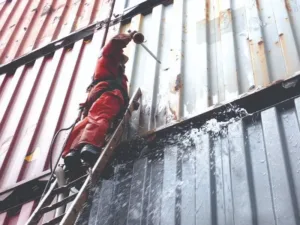Fire on board, amidst a sea of water, is ironically one of the most dangerous crew emergencies, necessitating early detection, a quick and well-informed response, effective leadership, teamwork, and more. Fortunately, fire is a rare occurrence within the Anglo-Eastern fleet, and when it does occur – in this case, due to the improperly kept and wrongly declared contents of a container that self-ignited – cool heads and a can-do, One Team spirit prevailed to save the day.
Shortly after midnight on June 16th, the crew of the Anglo-Eastern managed MV Celsius Nicosia were finally able to call it a day, having completed the container ship’s routine cargo operations in Singapore, which included discharging 284 containers and loading 321 new ones, increasing the overall total to 1,704 containers.
With everything in order, the ship departed for its next port of call in Dubai, which it was expected to reach in the morning of June 25th.
Less than four days into the voyage, however, what had started out as routine became anything but.
Soon after 12 noon on June 19th, during bridge watch duties, 2/O Pranay Kat observed what appeared to be smoke emanating from one of the containers in the forward bay, which he immediately brought to the attention of Capt. Shibu Babu. On checking with the deck crew, it was quickly established that there were no activities being carried out in the vicinity that could be the source of the smoke, and that the smoke was indeed coming from a container.
Capt. Babu wasted no time in sounding the general emergency alarm and calling all hands to proceed to the muster station, as required. With everyone clearly briefed about the situation, their roles, and what to do, the crew set about mounting a response. First, Capt. Babu reduced the ship’s speed to “dead slow ahead” in order to reduce and redirect the smoke, while the emergency response team (ERT) proceeded towards the source.
The container in question, located in the third tier, was quickly identified and reported by C/E Anurag Jayaram. Oddly, some pieces of charcoal were found on the deck. Meanwhile Capt. Babu had notified all relevant contacts and authorities of the situation, in addition to contacting the charterer for details about the cargo and advice on the best firefighting medium to deploy. According to the shipper, the container was packed with PVC panels, so flooding the entire container with water was deemed the best course of action.

As many hoses and ladders as possible were thus rigged up by the onboard ERT, with boundary cooling performed from the top of the second tier of containers. Meanwhile, braving rough seas and strong winds, one of the ship’s fearless able seamen climbed up two tied-together ladders as the only way to reach the smoking container and puncture a hole in its side for the deployment of a fire lance. However, he could now see flames and reported to C/E Jayaram that the bottom of the container had ruptured, with what appeared to be burning charcoal falling out.
Armed with this new information, C/E Jayaram gave the order to rig another hose in between the second- and third-tier containers and direct the water at the fallen charcoal. ETO Ankur Mishra, while monitoring the temperature of the container with an infrared gun, reported that the adjacent container was also experiencing a temperature rise. Fortunately, no dangerous goods were in the immediately adjacent containers, so the same boundary cooling was maintained. However, the adjacent bays contained Class 02 and Class 03 dangerous goods, which was some cause for concern.
Despite all these efforts, smoke continued to build up in the source container with no signs of abating, since the water flow from the fire lance was unable to outpace the volume leaking from the ruptured base. After brainstorming next steps, the onboard ERT decided it best to use an electric grinder to cut a couple of larger holes in the sides of the container, so that proper fire hoses could be deployed. This was even more challenging than the first effort with the fire lance, but A/B Ashok Bose was up to the task and executed it flawlessly.
As the holes were being cut, A/B Bose was able to see further inside the container. Contrary to the shipper’s declaration, not a single PVC panel lay in sight. Rather, the entire container was packed full with charcoal, which is known to self-heat and spontaneously combust if not properly kept, especially in a sealed environment like a container.
Following the surprise discovery, a total of three fire hoses were deployed through the enlarged openings, which had the desired effect of eventually flooding the container and reducing the amount of smoke being produced. Boundary cooling never ceased since the start of operations, with the crew working closely together as one team with one goal like no other – to contain and extinguish the fire for the sake of their own safety and lives.
Capt. Babu, in coordination with the charterer, made arrangements to divert the ship to Hambantota in Sri Lanka to discharge the container. The estimated time of arrival was 12 noon the next day, so the crew only had to remain vigilant and keep up the hard work for a few more hours before additional help and relief, which was good news that managed to keep spirits and confidence high.

Working continuously in shifts throughout the night and morning, the crew never once stopped dousing the container with water or ceased boundary cooling operations. It was tireless, unrelenting work, but the ship was making good headway towards Hambantota, and sure enough, the port came in sight a couple of hours earlier than expected.
Before berthing, the Sri Lankan authorities instructed Celsius Nicosia to remain 12 NM from shore to await an inspection by two P&I surveyors, which added back the time gained. Finally, after a thorough inspection, the ship was granted permission to proceed to the pilot station and be guided into port, where it berthed around 19:00 and underwent a second round of inspections by the port authorities.
The crew worked alongside the shore personnel to discharge the problem container, as well as a dozen adjacent ones to check for damage. In the end, all but two adjacent containers were loaded back onto the ship, after which Celsius Nicosia was safe to resume its original passage to Dubai, thus concluding a successful but exhausting 24+ hour emergency operation.
“We, the team Celsius Nicosia, are thankful to each other for working together as one team throughout this emergency. Without each other, this achievement would not have been possible,” said Capt. Babu, who cited the fire’s early detection and the crew’s continuous training and onboard drills as contributing factors to the smooth handling of the situation, which was commended by the owner in a heartfelt message of congratulations and thanks.
“The owner’s appreciation email and that from the office have kept the morale of all the crew members going and our enthusiasm shows that we are ready for any situation,” he added. Indeed, things may have heated up on board the ironically named Celsius Nicosia, but with their cool heads, effective leadership, excellent teamwork, and professionalism – not to mention courage and perseverance – the crew proved they have the “right stuff” to tackle any emergency!
Well done and big congratulations to Capt. Babu (during his first command, no less), C/E Jayaram, and the crew of Celsius Nicosia for demonstrating how it’s done.









